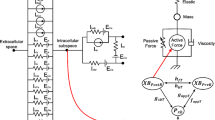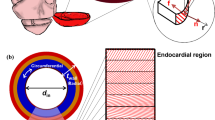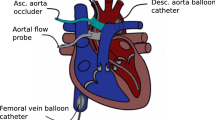Summary
We have reported that the postextrasystolic potentiation (PESP) decays in alternans or monotonically, respectively, depending on whether the first postextrasystolic beat interval has a compensatory pause or not, in the canine left ventricle. To get better mechanistic insight into the alternans PESP decay, we hypothesized that the myocardial mechanical restitution and potentiation could partly account for both types of PESP decay. To test this hypothesis, we simulated PESP decay on a computer using a documented equation combining myocardial mechanical restitution and potentiation. We changed the first postextrasystolic beat interval after a fixed extrasystolic beat interval without changing regular and other postextrasystolic beat intervals. The simulated PESP decayed in alternans or monotonically as a function only of the first postextrasystolic beat interval. Thus, the myocardial mechanical restitution and potentiation could partly account for both alternans and monotonic decay of PESP. We conclude that myocardial mechanical restitution and potentiation may partly underlie the initial two alternating beats, the first beat being the most potentiated and the second beat being the most depressed, of alternans PESP decay in the canine heart.
Similar content being viewed by others
References
Araki J, Takaki M, Matsushita T, Matsubara H, Suga H (1994) Postextrasystolic transient contractile alternans in canine hearts. Heart Vessels 9:241–248
Shimizu J, Takaki M, Kohno K, Araki J, Matsubara H, Suga H (1995) Sinusoidal and exponential decays of postextrasystolic transient alternans in excised bloodperfused canine hearts. Jpn J Physiol 45:837–848
Shimizu J, Matsubara H, Kohno K, Araki J, Takaki M, Suga H (1996) Transient mechanical alternans component always exists in postextrasystolic potentiation with and without compensatory pause (abstract). Circulation 94 (Suppl 1):I-724
Hata Y, Shimizu J, Hosogi S, Matsubara H, Araki J, Ohe T, Takaki M, Takasago T, Taylor TW, Suga H (1997) Ryanodine decreases internal Ca2+ recirculation fraction of the canine heart as studied by postextrasystolic transient alternans. Jpn J Physiol 47:521–530
Hosogi S, Araki J, Syuu Y, Suzuki S, Mohri S, Mikane T, Matsubara H, Ohe T, Hirakawa M, Suga H (1997) Calcium equally increases internal calcium recirculation fraction before and after β-blockade in canine left ventricles. Heart Vessels 12:280–286
Syuu Y, Araki J, Lee S, Suzuki S, Mizuno J, Mohri S, Mikane T, Shimizu J, Takaki M, Suga H (1998) Effects of Ca2+ and epinephrine on Ca2+ recirculation fraction and total Ca2+ handling in canine left ventricles. Jpn J Physiol 48:123–132
Shimizu J, Araki J, Mizuno J, Lee S, Syuu Y, Hosogi S, Mohri S, Mikane T, Takaki M, Taylor TW, Suga H (1998) A new integrative method to quantify total Ca2+ handling and futile Ca2+ cycling in failing hearts. Am J Physiol 275:H2325-H2333
McGaughey MD, Maughan WL, Sunagawa K, Sagawa K (1985) Alternating contractility in pulsus alternans studied in the isolated canine heart. Circulation 71:357–362
Spencer CI, Lab MJ, Seed WA (1992) Mechanical restitution during alternans in guinea pig papillary muscles. Cardiovasc Res 26:779–782
Lab MJ, Lee JA (1990) Changes in intracellular calcium during mechanical alternans in isolated ferret ventricular muscle. Circ Res 66:585–595
Schaefer S, Malloy CR, Schmitz JM, Dehmer GJ (1988) Clinical and hemodynamic characteristics of patients with inducible pulsus alternans. Am Heart J 115:1251–1257
Yue DT, Burkhoff D, Franz MR, Hunter WC, Sagawa K (1985) Postextrasystolic potentiation of the isolated canine left ventricle: relationship to mechanical restitution. Circ Res 56:340–350
Wier WG, Yue DT (1986) Intracellular calcium transients underlying the short-term force-interval relationship in ferret ventricular myocardium. J Physiol (Lond) 376:507–530
Suga H, Sagawa K, Shoukas AA (1973) Load independence of the instantaneous pressure-volume ratio of the canine left ventricle and effects of epinephrine and heart rate on the ratio. Circ Res 32:314–322
Morad M, Goldman Y (1973) Excitation-contraction coupling in heart muscle: membrane control of development of tension. Prog Biophys Mol Biol 27:257–313
Wohlfart B (1982) Analysis of mechanical alternans in rabbit papillary muscle. Acta Physiol Scand 115:405–414
Pfeiffer KP, Kenner T, Schaefer J (1984) Application of statistical methods for the analysis or interval related cardiac performance variations during cardiac arrhythmia in man. Cardiovasc Res 18:80–98
Seed WA, Noble MIM, Walker JM, Miller GAH, Pidgeon J, Redwood D, Wanless R, Franz MR, Schettler M, Schaefer J (1984) Relationships between beat-to-beat interval and the strength of contraction in the healthy and diseased human heart. Circulation 70:799–805
Noble MIM, Seed WA (eds) (1992) The interval-force relationship of the heart. Bowditch revisited. Cambridge University Press, Cambridge
Yamaguchi H, Takaki M, Ito H, Tachibana H, Lee S, Suga H (1997) Prossure-interval relationship characterizes left ventricular irregular beat contractilities and their mean level during atrial fibrillation. Jpn J Physiol 47:101–110
Suzuki S, Araki J, Morita T, Mohri S, Mikane T, Yamaguchi H, Sano S, Ohe T, Hirakawa M, Suga H (1998) Ventricular contractility in atrial fibrillation is predictable by mechanical restitution and potentiation. Am J Physiol 275:H1513-H1519
Author information
Authors and Affiliations
Additional information
This study was partly supported by Grants-in-Aid for Scientific Research (07508003, 09470009, 10558136, 10770307, 10877006) from the Ministry of Education, Science, Sports and Culture, and 1997–1998 Frontier Research Grants for Cardiovascular System Dynamics from the Science and Technology Agency, all of Japan.
Rights and permissions
About this article
Cite this article
Mohri, S., Araki, J., Imaoka, T. et al. Myocardial mechanical restitution and potentiation partly underlie alternans decay of postextrasystolic potentiation: Simulation. Heart Vessels 14, 82–89 (1999). https://doi.org/10.1007/BF02481747
Received:
Revised:
Accepted:
Issue Date:
DOI: https://doi.org/10.1007/BF02481747




